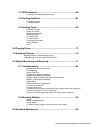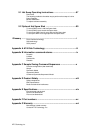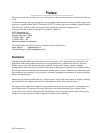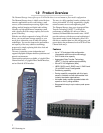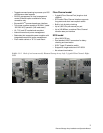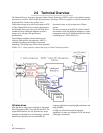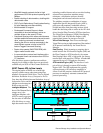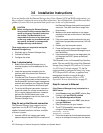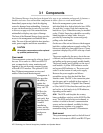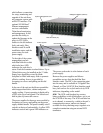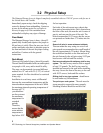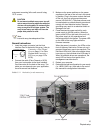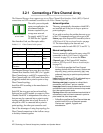
4
Diamond Storage Array Installation and Operation Manual
• UltraDMA transfer protocol similar to high
performance SCSI disk protocol operating at 66
MB/sec.
• Double-clocking of data transfers, doubling disk
data transfer rates
• CRC (Cyclic Redundancy Check) code allowing
full error detection and data reliability
• Multi-threaded I/O support
• Overlapped Command Support: allows
commands to be simultaneously active on
multiple drives on the same ATA bus.
• Command Queuing which allows simultaneous
multiple read/write commands to be sent to each
drive, reducing command overhead and
allowing the drive to service commands in the
most efficient manner: similar to the SCSI
feature Tagged Command Queuing.
• Faster drive speeds (5400/7200 RPM) with
higher media transfer rates
• A communication protocol and interface with a
fundamental lower cost structure than SCSI or
FC interfaces
ATA disk drives operate at performance and data
integrity levels similar to those that were previously
available only on SCSI or Fibre Channel disk drives.
ADXT Powers ATA to New Levels
The original notion of RAID was to build high
capacity, reliable storage subsystems using large
numbers of inexpensive disk drives. Thus its original
definition:
Redundant Array of Inexpensive Drives
.
Over time that definition became
Redundant Array of
Independent Drives
and the
inherent cost advantage in a
RAID system was lost.
Intelligent Midplane
The
heart of the Diamond Series
storage array is the
intelligent midplane with
ADXT
to sum or
aggregate
the data rates of individual
ATA disk drives to create
high data transfer rates. This
technology enables features such as serverless backup,
advanced error protection, metadata storage
techniques, virtualization software, thermal
management and advanced enclosure services.
The midplane contains a combination of custom
Application Specific Integrated Circuits (ASICs),
processors and proprietary embedded software
divided into three main processing sections which
handle the data being read or written to the ATA disk
drives from the Fibre Channel or SCSI host interfaces.
The Virtual Device Manager (VDM), Data Routing
Fabric (DRF) and ATA Interface Engines (AIE)
organize data streams for storage or retrieval.
Virtual Drive Manager
Data is accessed through
Virtual Drives using an implementation of the standard
SCSI protocol controlled by the Virtual Device
Manager.
Data Routing
Fabric incoming or outgoing data is
routed between the ATA Interface Engines (AIE) and
the Fibre Channel or SCSI interface by the custom
Data Routing Fabric ASIC, a high speed, low latency
transfer fabric with more than 2 GB/sec. of bandwidth
supported by up to 512 Megabytes of memory.
ATA Interface Engine (AIE)
The interface to each
pair of drives is through a custom ATA Interface
Engine ASIC. The AIE implements the typically
software-intensive ATA interface completely in
silicon. Each AIE contains a dedicated ATA protocol
processor to completely automate command and
protocol processing.
text
Disk 1
Disk 2
AIE
1
Disk 1
Disk 2
Disk 1
Disk 2
Disk 1
Disk 2
Disk 1
Disk 2
Disk 1
Disk 2
Disk 1
Disk 2
Disk 1
Disk 2
Disk 1
Disk 2
Disk 1
Disk 2
Disk 1
Disk 2
Disk 1
Disk 2
DATA ROUTING FABRIC
VIRTUAL DEVICE MANAGER
FIBRECHANNEL
INTERFACE 1
FIBRECHANNEL
INTERFACE 2
AIE
2
AIE
3
AIE
4
AIE
5
AIE
6
AIE
7
AIE
8
AIE
9
AIE
10
AIE
11
AIE
12



